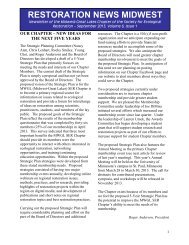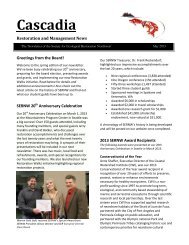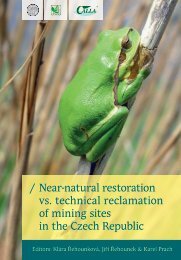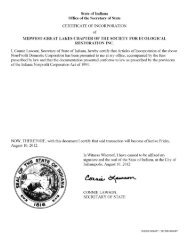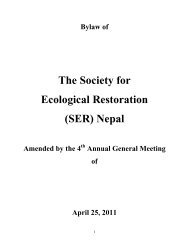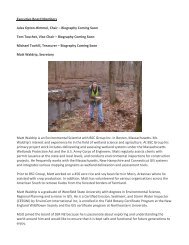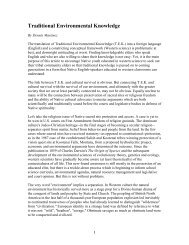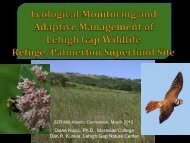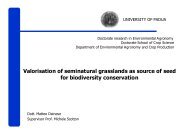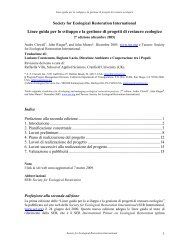THE WORLD CONFERENCE ON ECOLOGICAL RESTORATION
A Global Challenge - Society for Ecological Restoration
A Global Challenge - Society for Ecological Restoration
You also want an ePaper? Increase the reach of your titles
YUMPU automatically turns print PDFs into web optimized ePapers that Google loves.
2005 The World Conference on Ecological Restoration 45<br />
Restoration of desert abandoned agricultural fields<br />
Castellanos 1 A.E., J.L. Moreno 2 , R. Méndez 1<br />
1 DICTUS, Universidad de Sonora, Hermosillo, Sonora. Mexico. 83000<br />
2 Colegio de Sonora, Hermosillo, Sonora. Mexico 83000<br />
Biodiversity, functionality and productivity are main goals for restoration and rehabilitation practices.<br />
When large areas are involved, scaling of restoration goals should consider socioeconomic and desertification<br />
amelioration issues. When those issues are not considered, arid lands restoration and rehabilitation<br />
are perceived as “wasted” efforts that consume large amounts of capital resources. Abandoned agricultural<br />
fields in La Costa de Hermosillo within Sonoran desert habitats, have increased in the last 20<br />
years to a patchy landscape close to 100 thousand hectares. Restoration have been initiated considering<br />
previous ecological information on historical accounts, plant secondary succession and resource use<br />
strategies of dominant plant species in native desert ecosystems. Rehabilitation considers a matrix of different<br />
economic potentialities for specific native and introduced plant species into these new habitats. We<br />
conclude this paper reviewing the ecological and environmental considerations for developing a restoration<br />
strategy that can be successfully applied to abandoned agricultural fields in desert habitats.<br />
Keywords: desert secondary succession, abandoned agricultural fields, desertification, environmental<br />
costs, desert restoration.<br />
Ecological restoration of the gypsum quarry “Rio de Aguas” in Almeria (SE<br />
Spain) based on soils and floristic analyses<br />
Castelló R., J.M. Castillejo, J.M. Martín, J.L. de la Horra, C. Vizcayno, J. Pastor<br />
Centro de Ciencias Medioambientales, CSIC, Madrid<br />
This report describes a series of studies aimed at recovering a gypsum quarry area (Rio de Aguas, Sorbas,<br />
Almeria, Spain), which through years of mining has suffered intense degradation effects on landscape<br />
and geomorphology. The aim of the work was to minimize these effects. It was made a thorough<br />
evaluation of the flora and native vegetation of the quarry and its surroundings. The climate and soil of<br />
the area were defined and mapped in detail to establish a good time frame for installing a protective plant<br />
cover aimed at mitigating erosion-degradation and at integrating the landscape of the quarry within its<br />
natural setting. A physico-chemical and mineralogical analysis of the soil allowed to establish suitable<br />
amendments for the soil used to cover the area to be restored, mainly in terms of OM, total N and SO 4<br />
contents. Studies of flora and vegetation, specially in natural plant communities, have indicated the<br />
presence of numerous species (20% endemic) and their preference for the different landscape units.<br />
Thus, some taxa showed a preference for slopes, sunny or shady sites, gypsum substrates or basic nongypsum<br />
materials, and also different soil properties. In addition, based on endemism values and ecological<br />
preferences, we are presently creating a stock of seeds and have started greenhouse tests to evaluate<br />
the behavior of the different taxa.<br />
Keywords: landscape degradation, soils, flora, vegetation, ecological preferences.<br />
Problematic of hydrologic forest restoration in the semiarid/arid climate: the<br />
experiencein the mounts of the Vinalopó basin (Spain)<br />
Cavallé-Garrido A., M. Vigil<br />
TECNOMA S.A. Valencia. Spain<br />
Hydrologic-forest restoration in semiarid/ arid climate: the case of Vinalopó basin. Zone in semiarid climate<br />
gravely eroded as consequence of as anthropic as climatologic factors, due mainly to erroneous reforestations<br />
and adverse climatic conditions characterised for the scanty of precipitation and torrential<br />
rains episodes. The treated themes are the problematic of reforestation in these mounts and the necessary<br />
actions to get a satisfactory hydrologic-forest restoration in this environment. Application of new<br />
techniques for water utilisation. Importance of implantation irrigation. Physic and biologic techniques for<br />
erosion correction.<br />
Keybords: hydrologic-forest restoration, semiarid, erosion, water utilisation, irrigation, reforestation<br />
techniques.



